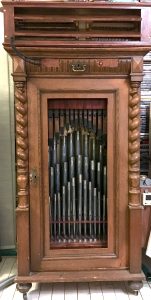One organ is not enough. That much is obvious. We’ve already got a full diapason/principal rank in the PipeDream61, but no swell division and no reeds. That won’t do. That much is just as obvious. Luckily, we got our hands on a nice-looking old oak cupboard and thought, Hey! Why not fill it with organ pipes? So, the plan is to stuff a rank of harmonic piccolos, a (reduced) rank of wooden flute pipes and the reed ranks from an old harmonica into/onto the cupboard. To complicate matters, we are going to convert the cupboard panel door to a set of swell shades.
To supply this monster with air, we need to upgrade our blower setup. This is described on the PipeWind v.2 project page.
PROJECT OVERVIEW
The project is built around an old 150 cm (5 ft) tall cupboard. We can’t fit all three instruments (piccolos, flutes and accordion) inside the cupboard, so the accordion will be placed on top in an enclosure of it’s own.
The piccolos are placed on a windchest in the bottom of the cupboard, while placing the wood flutes will be a bit more difficult. Their windchest will be placed at the top of inside of the cupboard, with the flutes hanging upside-down. The accordion is placed on top of the cupboard.
The cupboard has a small drawer at the top which will be an ideal location for the controller and all the electronics: power supplies, microcontrollers, valve drivers etc.
On the side of the cupboard we’ll have a manifold that distributes air from the PipeWind v.2 blower to up to 5 air outputs. It will also have a medium sized schwimmer to deal with transient pressure changes.
SCHWELLWERK
The main PipeMare cabinet has a nice door with a single panel with carved decorations (see image to the right). Of course, a closed door is no good with two pipe organs inside, but it would also be a shame to just remove the panel or even the entire door. So, we don’t.
Instead, the door panel filling will be cut up vertically into 4 swell panels, which will be made to pivot together using a small geared motor. Besides the obviously stunning visual effect, it will also allow us a bit of control of the volume of the two pipe ranks inside the cupboard.
The 4 panels will be reattached to the panel frame on ball bearings at the top and bottom, so the 4 long boards can swivel around their vertical center axis.
The boards will be connected on the inside of the door so they open and close in sync using a silent, geared DC motor. A pair of microswitches are used as sensors in the two extreme positions (fully closed and fully open). We are going to do the very same thing for the PipeMare accordion on top of the cupboard, only horizontally.
The swell shades will be controlled through a MIDI/EBP channel dedicated to controls like this. The swell panel motor will be driven by a regular dual half-H driver (SN754410NE, L293D or similar) through a set of optocouplers to isolate the motor from the same power domain as the microcontroller.
Now, of course, they will never be as effective as a real schwellwerk, where the swell division is placed in a closed chamber and the swell panels are made of 1-2 inches thick heavy wood. Our “swell chamber” is a wooden cabinet, not exactly sound proof, and certainly not made of thick wood, so the effect will be more subtle. But it’ll be there, and let’s not forget the visual effect.
And speaking of visual effect, the inside of the cupboard as well as the accordion is painted gold. This is to enhance the effect of the planned PWM-controlled LED illumination. In both the tubular bells and PipeDream61 we use LEDs mounted across the individual solenoids, making them light up when activating the solenoids. In the PipeDream61 the LEDs illuminate only the actual solenoids, visible through an acrylic glass front on the windchest.
Here in PipeMare, however, we are placing the LEDs inside the cabinet, illuminating the pipes or, in the case of the accordion, the reed ranks. There won’t be an LED for each note/pipe, but the light will be controlled by the slave microcontroller and even more synced to the music.
PIPEMARE PAGES
Read more about the PipeMare parts here:
- PipeMare Accordion: The deconstructed accordion with swell shades. placed on top of the cupboard.
- PipeMare Piccolo: 44-pipe harmonic pipes in the bottom of the cupboard
- PipeMare Flute: The 31-note wooden gedackt flute organ, placed upside-down inside the cupboard.
- PipeMare controller circuitry: The slave controller circuit for the three organs, swell shades, power supplies and everything else.
- PipeWind v.2: Our upgraded blower/regulator system, designed and built specifically to supply PipeMare with enough air.
Next: Read about the PipeMare Accordion




This is awesome! Very inspiring.